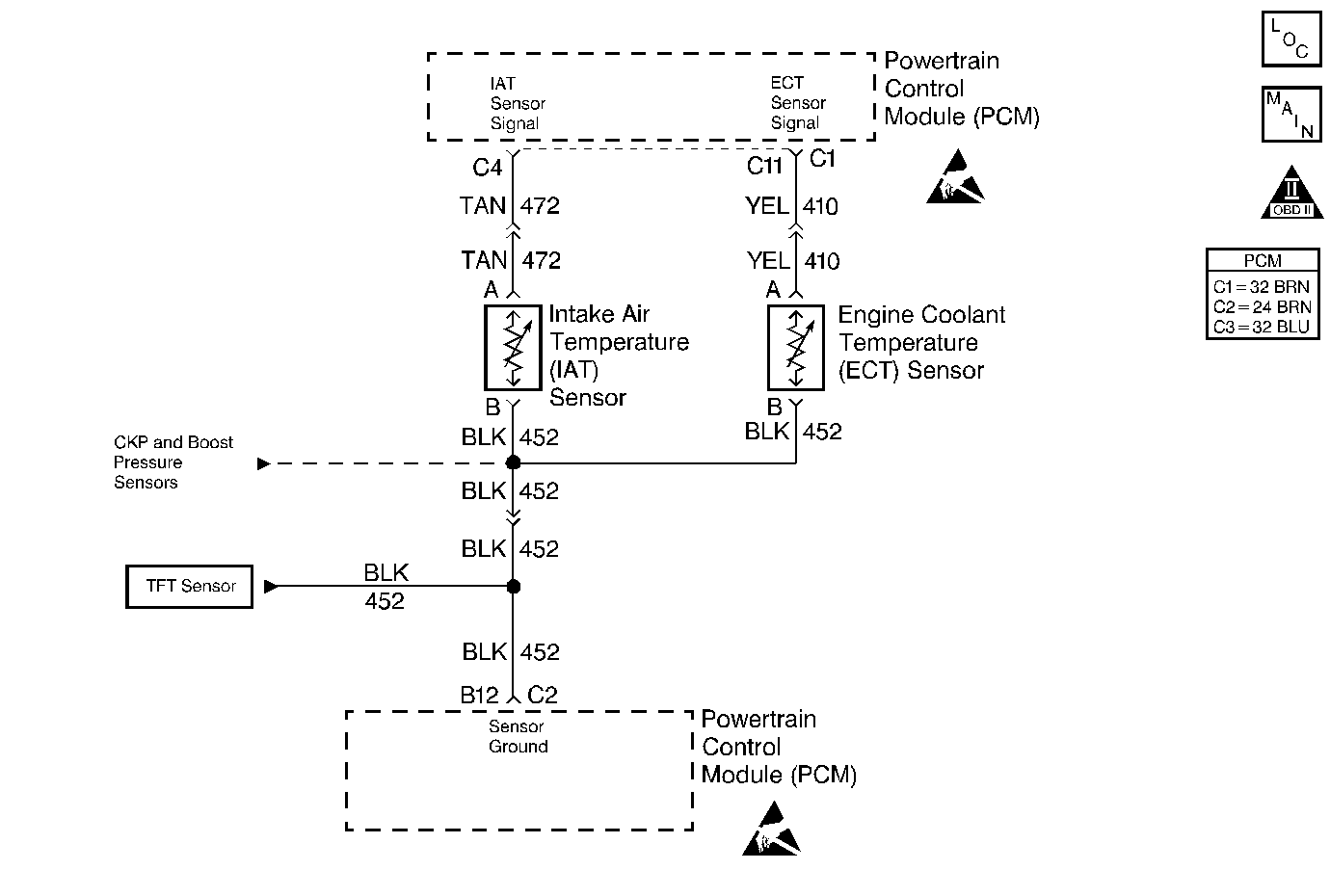
Circuit Description
The Engine Coolant Temperature (ECT) sensor is a thermistor that controls signal voltage to the PCM. When the engine is cold, the sensor resistance is high, therefore the PCM will see a high signal voltage. As the engine warms, the sensor resistance becomes less and the voltage drops. The voltage measured across the thermister is interpreted as a temperature.
Conditions for Setting the DTC
| • | The PCM performs this DTC diangostic continuously. |
| • | The engine coolant temperature is greater than or equal to 151°C (304°F) for 2 seconds. |
| • | All of the diagnostic set conditions met for 2 seconds. |
Action Taken When the DTC Sets
| • | The PCM illuminates the Malfunction Indicator Lamp (MIL) on the second consecutive drive trip the diagnostic runs and fails. |
| • | The PCM records the operating conditions at the time the diagnostic fails. The first time the diagnostic fails, the Failure Records store this information. If the diagnostic reports a failure on the second consecutive drive trip, the Freeze Frame records the operating conditions at the time of failure and updates the Failure Records. |
Conditions for Clearing the MIL/DTC
| • | The PCM will turn the MIL off after three consecutive trips without a fault condition. |
| • | A History DTC will clear after forty consecutive warm-up cycles during which the diagnostic does not fail (the coolant temperature has risen 5°C (40°F) from the start up coolant temperature and the engine coolant temperature exceeds 71°C (160°F) during that same ignition cycle). |
| • | Use of a Scan Tool. |
Diagnostic Aids
Check the harness routing for a potential short to ground. After the engine has started, the ECT temperature should rise steady to about 85°C (185°F). A mis-scaled sensor could result in poor driveability complaints. Refer to Temperature vs Resistance .
Test Description
The numbers below refer to the step numbers on the diagnostic table.
-
If the fault is still present, the engine coolant voltage will greater than 151°C (303°F).
-
This test simulates a DTC P0117. If the PCM recognizes the high signal voltage (low temperature) the PCM and the wiring are okay.
-
This step will determine if the problem is a short to ground or a malfunctioning PCM.
Step | Action | Value(s) | Yes | No |
|---|---|---|---|---|
1 |
Important: Before clearing any DTCs, use the Scan Tool Capture Info to save freeze frame and failure records for reference, as the Scan Tool loses data when using the Clear Info function. Was the Powertrain On-Board Diagnostic (OBD) System Check performed? | -- | Go to A Powertrain On Board Diagnostic (OBD) System Check | |
Does the Scan Tool display an ECT greater than or equal to the specified value? | 151°C (304°F) | |||
Does the Scan Tool display an ECT temperature colder than or equal to the specified value? | -30°C (-22°F) | |||
Is the resistance at the specified value? | ∞ | |||
5 | The DTC is intermittent. If no additional DTCs are stored, refer to the Diagnostic Aids. If the additional DTCs are stored, refer to those tables first. Are there any additional DTCs stored? | -- | Go to the applicable DTC table | Go to Diagnostic Aids |
6 | Repair the short to the ground in the ECT signal circuit. Refer to Wiring Repairs in Wiring Systems. Is the action complete? | -- | -- | |
7 | Replace the ECT sensor. Refer to Engine Coolant Temperature (ECT) Sensor Replacement . Is the replacement complete? | -- | -- | |
8 | Replace the PCM. Important: If the PCM is malfunctioning, reprogram the PCM. Refer to PCM Replacement/Programming . Is the replacement complete? | -- | -- | |
9 |
Does the Scan Tool indicate the diagnostic Passed? | -- | ||
10 | Does the Scan Tool display any additional undiagnosed DTCs? | -- | Go to the applicable DTC table | System OK |
